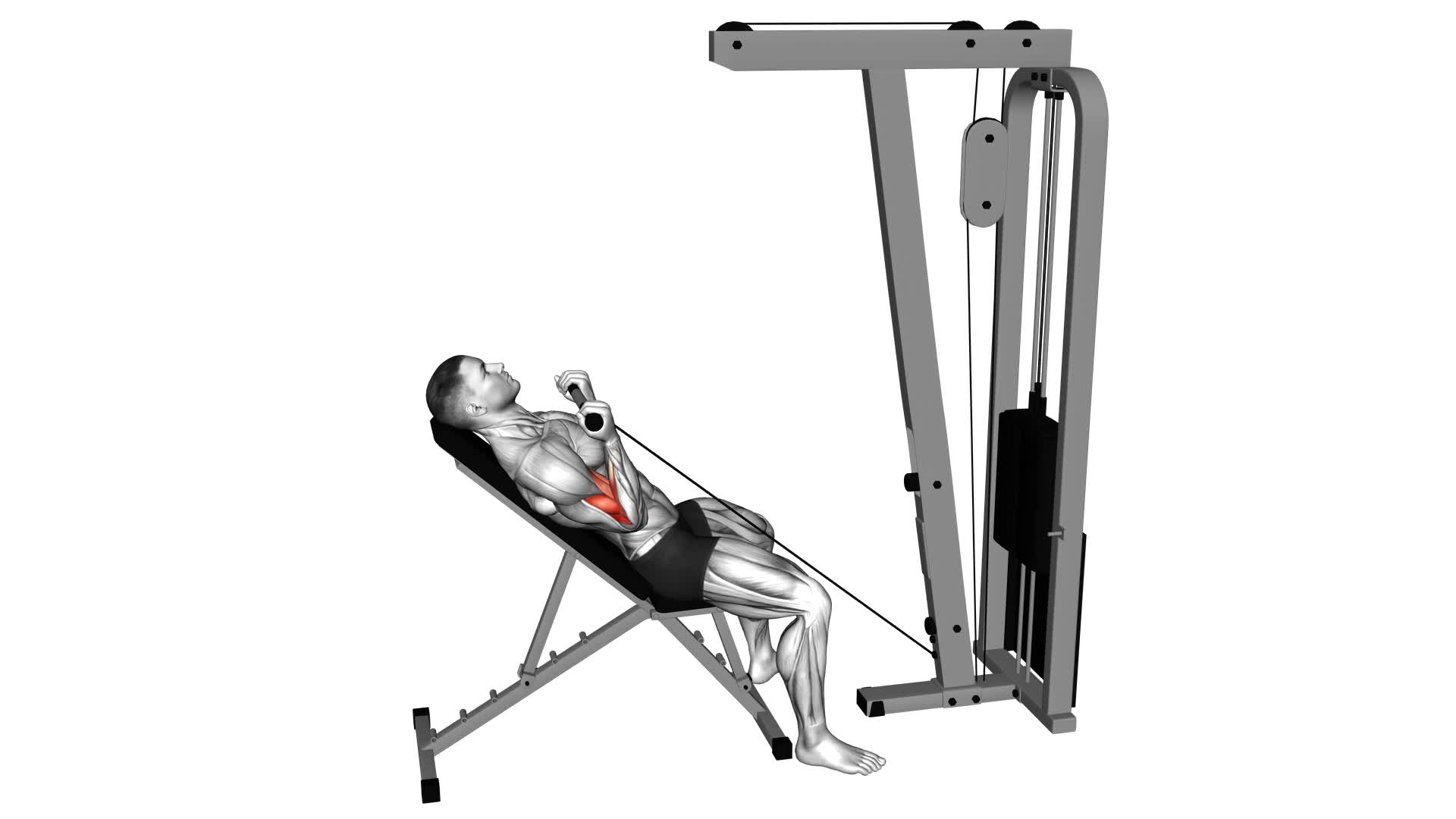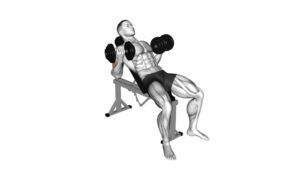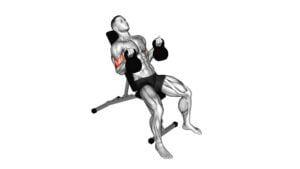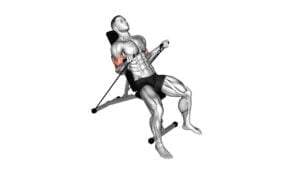Cable Incline Biceps Curl – Video Exercise Guide & Tips

Are you looking to tone and strengthen your biceps? Look no further than the cable incline biceps curl! This exercise targets your biceps, helping you achieve those defined, sculpted arms you've always wanted.
Watch This Exercise Video
In this video exercise guide, we'll show you the proper equipment setup, correct body positioning, and execution of the exercise. We'll also provide variations for added challenge, common mistakes to avoid, and tips for maximum biceps activation.
Get ready to transform your arms with this effective workout!
Key Takeaways
- Proper equipment setup and body positioning are crucial for safety and effectiveness
- Focus on maintaining proper form and technique throughout the exercise
- Gradually increase resistance levels and incorporate variations for added challenge
- Maintain constant tension on the biceps and engage core muscles for maximum activation
Proper Equipment Setup
Set up the equipment by attaching the cable to the incline bench.
When performing cable incline biceps curls, proper equipment selection and safety precautions are essential for an effective and safe workout.
First, ensure that you have chosen the appropriate cable machine for this exercise. Look for a machine with adjustable weight resistance and a smooth pulley system. This will allow for a controlled and targeted workout for your biceps.
Additionally, make sure the cable is securely attached to the incline bench. This will prevent any accidents or injuries during your workout. Safety precautions should always be a priority when using any exercise equipment.
Before starting the exercise, check for any loose or damaged parts. Adjust the weight resistance to a level that suits your fitness level and goals. It's also advisable to warm up your muscles before beginning the exercise to reduce the risk of injury.
By following these proper equipment selection and safety precautions, you can ensure a safe and effective cable incline biceps curl workout.
Now, let's move on to the next section where we'll discuss the correct body positioning for this exercise.
Correct Body Positioning
To achieve proper form during the cable incline biceps curl, position yourself on the incline bench with your feet firmly planted on the floor. This will ensure proper body alignment and maximize muscle engagement.
Here are some key points to keep in mind:
- Sit on the incline bench: Position yourself so that your back is firmly against the bench and your body is at a slight incline.
- Plant your feet: Keep your feet flat on the floor, shoulder-width apart, to provide a stable base of support.
- Maintain a neutral spine: Keep your spine in a straight, neutral position throughout the exercise. Avoid arching your back or hunching your shoulders.
- Engage your core: Contract your abdominal muscles to stabilize your torso and maintain proper alignment.
By following these guidelines, you'll ensure that your body is in the correct position for optimal muscle engagement and reduce the risk of injury.
Remember to focus on proper form and technique to get the most out of your cable incline biceps curl workout.
Execution of the Exercise
To properly execute the cable incline biceps curl exercise, regularly adjust the weight and ensure a full range of motion for maximum effectiveness. Start by setting the cable machine at a low pulley position and attaching a straight bar handle. Sit on an incline bench facing away from the machine and grab the handle with an underhand grip, shoulder-width apart. Position your upper arms against the pad and keep your elbows slightly bent. This is your starting position.
As you exhale, curl the handle towards your shoulders while keeping your upper arms stationary. Contract your biceps and hold for a brief pause at the top of the movement. Inhale as you slowly lower the handle back to the starting position, maintaining control throughout the entire exercise.
Proper breathing technique is important during the cable incline biceps curl. Inhale before starting the curl, and exhale as you lift the handle towards your shoulders. This helps stabilize your core and provides support during the movement.
The cable incline biceps curl offers several benefits. It targets the biceps brachii muscle, helping to increase arm strength and size. It also engages the brachialis muscle, which lies underneath the biceps and contributes to overall arm definition. Additionally, this exercise improves grip strength and stability in the shoulder joint. By maintaining proper form and using an appropriate weight, you can maximize the benefits of the cable incline biceps curl.
Variations for Added Challenge
To add more challenge to your cable incline biceps curl, there are several advanced modification options you can try.
One option is to increase the resistance levels by adding more weight to the cable machine.
Another option is to focus on improving your form and technique, such as maintaining strict control of the movement and avoiding swinging or using momentum.
These variations will help you target your biceps even more effectively and continue to challenge your muscles.
Advanced Modification Options
For an added challenge, incorporate advanced modification options into your cable incline biceps curl routine. These options allow you to increase resistance levels and push yourself further. Here are four variations to take your workout to the next level:
- Single-arm cable incline biceps curl: Perform the exercise with one arm at a time to engage your biceps more intensely and improve stability.
- Superset with hammer curls: Alternate between cable incline biceps curls and hammer curls to target different areas of your biceps and forearm muscles.
- Slow eccentric curls: Focus on the lowering phase of the exercise by slowing it down. This increases time under tension and promotes muscle growth.
- Isometric holds: Pause at the top of the curl and hold the position for a few seconds. This challenges your biceps and builds strength.
Incorporating these advanced modification options will help you overcome plateaus and continue progressing in your cable incline biceps curl routine.
Increasing Resistance Levels
Incorporate these variations to enhance the resistance levels and challenge yourself even further in your cable incline biceps curl routine.
To increase intensity and achieve progressive overload, you can start by using heavier weights. Gradually increase the weight as you become more comfortable and confident.
Another option is to perform the exercise at a slower pace, focusing on the eccentric (lowering) phase of the movement. This puts more stress on the muscles and increases the intensity.
Additionally, you can try incorporating supersets or drop sets into your routine. Supersets involve performing another exercise immediately after completing a set of cable incline biceps curls, targeting the same muscle group. Drop sets involve decreasing the weight after reaching muscle fatigue, allowing you to continue the exercise with lighter weights.
These variations will help you continually challenge your muscles and promote strength gains.
Form and Technique Improvements
Improve your form and technique for added challenge in the cable incline biceps curl by focusing on proper body alignment and controlled movements. Here are some tips to enhance your performance:
- Improving mind-muscle connection: Concentrate on feeling the contraction in your biceps throughout the exercise. Visualize your muscles working and connect your mind with the movement.
- Incorporating tempo training: Vary the speed at which you perform the exercise. Try slowing down the eccentric (lowering) phase to increase time under tension and maximize muscle activation.
- Maintaining proper posture: Keep your back straight and shoulders pulled back throughout the movement. This ensures that your biceps are the primary muscles engaged.
- Controlling the weight: Avoid using momentum or swinging the weight. Instead, focus on controlled and deliberate movements, allowing your biceps to do the work.
Common Mistakes to Avoid
When performing the cable incline biceps curl, it's crucial to maintain proper form throughout the exercise. This includes keeping your back flat against the bench, engaging your core, and not arching your lower back.
Additionally, it's important to avoid using excessive weight that could compromise your form and lead to injury.
Proper Form Demonstration
To perform the Cable Incline Biceps Curl with proper form, you should focus on maintaining a stable and controlled movement throughout the exercise. Here are some important points to keep in mind:
- Benefits of using cables for biceps curls:
- Cables provide constant tension on the biceps throughout the entire range of motion, leading to better muscle activation and growth.
- Cables allow for a greater variety of exercises and angles, targeting different areas of the biceps for more balanced development.
- Cables can help improve grip strength, as you need to maintain control of the handles throughout the movement.
- Cables offer a safer alternative to free weights, reducing the risk of injury while still providing an effective workout.
- Importance of proper breathing technique during the exercise:
- Breathe out as you curl the weight up, engaging your core and helping to stabilize your body.
- Inhale as you lower the weight, maintaining control and keeping your muscles engaged.
Avoiding Excessive Weight
To avoid using excessive weight, focus on selecting a challenging yet manageable load for the Cable Incline Biceps Curl. Using too much weight can increase the risk of injury and hinder your progression. Start with a weight that allows you to maintain proper form and complete the exercise with control.
As you become stronger and more comfortable, gradually increase the weight in small increments to continue challenging your muscles. Remember, the goal isn't to lift the heaviest weight possible, but to perform the exercise correctly and effectively.
Importance of Controlled Movement
Maintaining controlled movement is crucial for the Cable Incline Biceps Curl, as it not only builds muscle strength but also helps prevent common mistakes and potential injury. To fully understand the importance of controlled movement, consider the following:
- Importance of tempo control: By maintaining a controlled tempo throughout the exercise, you can effectively target and engage the biceps muscles, maximizing their activation and growth.
- Benefits of slow eccentric movements: The eccentric phase, where you lower the weight, is just as important as the concentric phase. By performing slow and controlled eccentric movements, you create more tension in the muscles, leading to greater muscle fiber recruitment and overall muscle development.
- Avoiding swinging or jerking motions: Maintaining control prevents any swinging or jerking motions, which can shift the focus away from the biceps and onto other muscles, reducing the effectiveness of the exercise.
- Preventing potential injury: Controlled movement ensures that you maintain proper form and alignment, reducing the risk of strain or injury to your joints and muscles.
Tips for Maximum Biceps Activation
Focus on gripping the cable handle tightly throughout the entire exercise to maximize biceps activation. This is crucial for achieving maximum biceps growth and getting the most out of your workout. By maintaining a strong grip, you engage the muscles in your hands and forearms, which in turn helps to recruit more muscle fibers in your biceps.
In addition to gripping the handle tightly, it's important to focus on proper form and technique. Keep your elbows tucked in by your sides and avoid swinging or using momentum to lift the weight. This will ensure that the tension remains on your biceps throughout the movement, leading to more effective biceps exercises.
Another tip for maximizing biceps activation is to control the speed of the exercise. Slow and controlled movements can help to increase time under tension, which is key for muscle growth. Avoid rushing through the exercise and instead, focus on a controlled and deliberate contraction of your biceps as you curl the weight up.
Lastly, don't forget to incorporate variations into your biceps workout routine. This will help to challenge your muscles in different ways and prevent plateauing. Some effective variations include using different grips, such as underhand or hammer grip, and varying the angle of the incline bench.
Frequently Asked Questions
How Many Sets and Reps Should I Do for Cable Incline Biceps Curls?
To maximize the benefits of cable incline biceps curls, it's important to consider the number of sets and reps. While the specific numbers may vary depending on your fitness level and goals, a good starting point is 3-4 sets of 8-12 reps.
This will help build strength and muscle endurance in your biceps. Remember to choose a weight that challenges you, but still allows you to maintain proper form throughout the exercise.
Can I Use Dumbbells Instead of a Cable Machine for This Exercise?
Yes, you can definitely use dumbbells instead of a cable machine for the cable incline biceps curls exercise. Using dumbbells is a great alternative for this exercise and can provide a similar level of resistance and targeting for your biceps.
Additionally, there are many other exercises you can do with dumbbells to work your biceps, such as dumbbell curls and hammer curls.
Should I Squeeze or Hold the Bicep Contraction at the Top of the Movement?
When performing the cable incline biceps curl, you might wonder whether to squeeze or hold the bicep contraction at the top. Both methods have their benefits.
Squeezing the contraction can help to fully engage and activate the bicep muscles, leading to better muscle growth.
On the other hand, holding the contraction at the top can help to increase time under tension, which can also contribute to muscle growth.
Experiment with both techniques and see which one feels more effective for you.
Is It Necessary to Warm up Before Performing Cable Incline Biceps Curls?
Before performing cable incline biceps curls, warming up is necessary for several reasons.
A proper warm-up can help increase blood flow to the muscles, improve flexibility, and reduce the risk of injury.
It also prepares your body for the exercise by activating the muscles you'll be targeting.
To perform cable incline biceps curls correctly, maintain proper form and technique by keeping your back against the bench, elbows close to your sides, and focusing on contracting the biceps throughout the movement.
Can This Exercise Be Performed by Beginners or Is It More Suitable for Advanced Lifters?
For beginners, the cable incline biceps curl exercise might be a bit challenging at first. However, with some modification options, you can still give it a try.
Start with lighter weights and focus on proper form. Avoid common mistakes like using momentum or swinging your body.
Take your time and gradually increase the intensity as you get more comfortable. Remember, practice makes perfect, so keep at it and you'll see progress.
Conclusion
Overall, the cable incline biceps curl is an effective exercise for targeting and activating the biceps muscles. By setting up the equipment correctly, maintaining proper body positioning, and executing the exercise with control, you can maximize your biceps activation.
Additionally, incorporating variations for added challenge and avoiding common mistakes will help ensure you get the most out of this exercise. Remember to consult a professional before starting any new exercise routine.

Author
Years ago, the spark of my life’s passion ignited in my mind the moment I stepped into the local gym for the first time. The inaugural bead of perspiration, the initial endeavor, the very first surge of endorphins, and a sense of pride that washed over me post-workout marked the beginning of my deep-seated interest in strength sports, fitness, and sports nutrition. This very curiosity blossomed rapidly into a profound fascination, propelling me to earn a Master’s degree in Physical Education from the Academy of Physical Education in Krakow, followed by a Sports Manager diploma from the Jagiellonian University. My journey of growth led me to gain more specialized qualifications, such as being a certified personal trainer with a focus on sports dietetics, a lifeguard, and an instructor for wellness and corrective gymnastics. Theoretical knowledge paired seamlessly with practical experience, reinforcing my belief that the transformation of individuals under my guidance was also a reflection of my personal growth. This belief holds true even today. Each day, I strive to push the boundaries and explore new realms. These realms gently elevate me to greater heights. The unique combination of passion for my field and the continuous quest for growth fuels my drive to break new ground.



